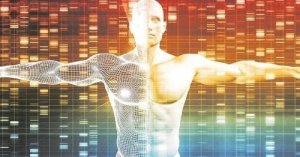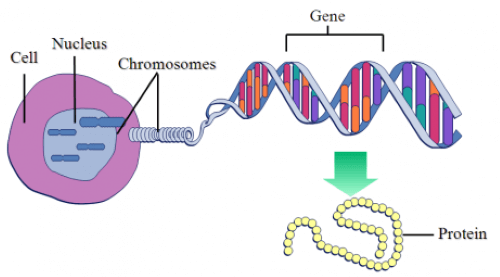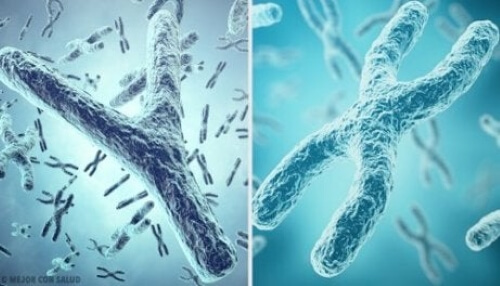Genetics for Children: What Are Genes and Chromosomes?

This article explains genetics for children in a simple way so we can understand why we tend to look like our parents.
All living things have a group of tightly bound molecules in their cells that are called DNA. These molecules contain the instructions for the formation of each person, animal, plant or insect, as well as the information necessary for the correct functioning of the organism. In addition, they also transmit the genetic material from the parents to their offspring.
But what is really responsible for transmitting the qualities that make us who we are? The component that is responsible for our physical appearance and our way of being is our genes. And what are genes? What are chromosomes? We’ll explain further below.
What are genes? Genetics for children: Decoding DNA
Genes are segments of DNA that store genetic information. The units also contain sequences of nucleotides at their extremes that indicate where the reading of that gene begins and ends.
In between these sequences of beginnings and ends is the message, a concrete and ordered sequence of nucleotides. They believe that DNA contains 25,000 codifying genes. In addition, the genes are grouped into other structures called chromosomes.
Each gene carries out a special and very important mission. All of them contain coded information that allow them to form molecules we call proteins. The proteins are responsible for forming a structure like bones, but can also contain the material for regulating the metabolic functioning of the body.

If for some reason in the process improper codes make erroneous proteins, that error could be small and undetectable or also of immense consequence. For example, improperly coded genetic information can sometimes cause significant disabilities.
The genes, nonetheless, are in charge of transmitting and conserving hereditary traits. When a physical feature, like the color of one’s hair, is transmitted from parents to children, we’re talking about dominant genes.
The set of genes from one species is known as the genome, and the scientists who study this are called geneticists and they work in a field called genetics. For example, the human genome project finished decoding our genome in 2016.
What are chromosomes? Genetics for children: condensing DNA
We can say, in a language of genetics for children, that a chromosome is a condensed structure containing DNA molecules. In addition, the degree of condensation of the chromosomes will depend on whether the cell is in division or not.
The nucleus of animal and vegetal eukaryotic cells contain chromosomes. In them, they store most part of our genetic information, and the rest is located in mitochondrial DNA. Moreover, the number of chromosomes present in each cell for each species is always constant.
The cells of a human being contain 46 chromosomes grouped in 23 pairs. Geneticists call pairs 1-22 as autosomes or non-sex chromosomes. The 23rd pair are the sex chromosomes X and Y, and they determine the sex of a person: two XX chromosomes for women and a pair that is one X and one Y chromosome for men. The length of chromosomes vary but the longest human chromosome is approximately 10 micrometers in length. We can see them with a high-resolution microscope.
Types of chromosomes
There are various criteria to identify every one of the 23 pairs of chromosomes according to their size, their form, and the way they absorb dies in the laboratory. But in this article concerning genetics for children, we’re going to focus on the position of the centromere.

The metaphase chromosomes (in their state of maximum condensation) possess a characteristic X shape, and scientists call the point where the two threads meet the centromere. We can, therefore, classify them in 4 groups:
- Metacentric: the centromere is located more or less at the middle of the chromosome.
- Submetacentric: the centromere location isn’t at the exact center of the chromosome.
- Allocentric: the centromere location is almost at one extreme of the chromosome
- Telocentric: the centromere is at the very extreme of the chromosome. As a consequence, these chromosomes look like a single thread instead of an X.
How do we inherit physical traits?
During sexual reproduction, the father and mother each contribute one set of homologous chromosomes, which is 23 chromosomes from each progenitor. As a consequence, each of us is the result of 50% of our parents. This explains why one sibling can be blonde with green eyes, like their mother, and the other can have brown hair with blue eyes, like their father.
Homologous chromosomes contain the same genes and form part of the same pair. On occasion, this distribution of homologous chromosomes doesn’t carry out correctly. After the period of cell division, the number of chromosomes observed is abnormal.
An example of this are people with Down Syndrome, who present three chromosomes for the 21st pair. This is also called Trisomy 21.
“Science, my lad, is made up of mistakes, but they are mistakes which it is useful to make because they lead little by little to the truth.”
– Jules Verne –
This article explains genetics for children in a simple way so we can understand why we tend to look like our parents.
All living things have a group of tightly bound molecules in their cells that are called DNA. These molecules contain the instructions for the formation of each person, animal, plant or insect, as well as the information necessary for the correct functioning of the organism. In addition, they also transmit the genetic material from the parents to their offspring.
But what is really responsible for transmitting the qualities that make us who we are? The component that is responsible for our physical appearance and our way of being is our genes. And what are genes? What are chromosomes? We’ll explain further below.
What are genes? Genetics for children: Decoding DNA
Genes are segments of DNA that store genetic information. The units also contain sequences of nucleotides at their extremes that indicate where the reading of that gene begins and ends.
In between these sequences of beginnings and ends is the message, a concrete and ordered sequence of nucleotides. They believe that DNA contains 25,000 codifying genes. In addition, the genes are grouped into other structures called chromosomes.
Each gene carries out a special and very important mission. All of them contain coded information that allow them to form molecules we call proteins. The proteins are responsible for forming a structure like bones, but can also contain the material for regulating the metabolic functioning of the body.

If for some reason in the process improper codes make erroneous proteins, that error could be small and undetectable or also of immense consequence. For example, improperly coded genetic information can sometimes cause significant disabilities.
The genes, nonetheless, are in charge of transmitting and conserving hereditary traits. When a physical feature, like the color of one’s hair, is transmitted from parents to children, we’re talking about dominant genes.
The set of genes from one species is known as the genome, and the scientists who study this are called geneticists and they work in a field called genetics. For example, the human genome project finished decoding our genome in 2016.
What are chromosomes? Genetics for children: condensing DNA
We can say, in a language of genetics for children, that a chromosome is a condensed structure containing DNA molecules. In addition, the degree of condensation of the chromosomes will depend on whether the cell is in division or not.
The nucleus of animal and vegetal eukaryotic cells contain chromosomes. In them, they store most part of our genetic information, and the rest is located in mitochondrial DNA. Moreover, the number of chromosomes present in each cell for each species is always constant.
The cells of a human being contain 46 chromosomes grouped in 23 pairs. Geneticists call pairs 1-22 as autosomes or non-sex chromosomes. The 23rd pair are the sex chromosomes X and Y, and they determine the sex of a person: two XX chromosomes for women and a pair that is one X and one Y chromosome for men. The length of chromosomes vary but the longest human chromosome is approximately 10 micrometers in length. We can see them with a high-resolution microscope.
Types of chromosomes
There are various criteria to identify every one of the 23 pairs of chromosomes according to their size, their form, and the way they absorb dies in the laboratory. But in this article concerning genetics for children, we’re going to focus on the position of the centromere.

The metaphase chromosomes (in their state of maximum condensation) possess a characteristic X shape, and scientists call the point where the two threads meet the centromere. We can, therefore, classify them in 4 groups:
- Metacentric: the centromere is located more or less at the middle of the chromosome.
- Submetacentric: the centromere location isn’t at the exact center of the chromosome.
- Allocentric: the centromere location is almost at one extreme of the chromosome
- Telocentric: the centromere is at the very extreme of the chromosome. As a consequence, these chromosomes look like a single thread instead of an X.
How do we inherit physical traits?
During sexual reproduction, the father and mother each contribute one set of homologous chromosomes, which is 23 chromosomes from each progenitor. As a consequence, each of us is the result of 50% of our parents. This explains why one sibling can be blonde with green eyes, like their mother, and the other can have brown hair with blue eyes, like their father.
Homologous chromosomes contain the same genes and form part of the same pair. On occasion, this distribution of homologous chromosomes doesn’t carry out correctly. After the period of cell division, the number of chromosomes observed is abnormal.
An example of this are people with Down Syndrome, who present three chromosomes for the 21st pair. This is also called Trisomy 21.
“Science, my lad, is made up of mistakes, but they are mistakes which it is useful to make because they lead little by little to the truth.”
– Jules Verne –
All cited sources were thoroughly reviewed by our team to ensure their quality, reliability, currency, and validity. The bibliography of this article was considered reliable and of academic or scientific accuracy.
- Nina Powell-Hamilton, MD. Todo sobre genética [artículo en web]. Recuperado de: kidshealth.org
- Pérez Porto, J. (2010). Definición de Gen [artículo en web]. Recuperado de: https://definicion.de/gen/
- Pérez Porto, J. y Gardey, A. (2017). Definición de Cromosoma [artículo en web]. Recuperado de: https://definicion.de/cromosoma/
- Vivien, L. y Narcisa, MS. (marzo 2014). Qué es un gen [artículo en web]. Recuperado de: kidshealth.org
This text is provided for informational purposes only and does not replace consultation with a professional. If in doubt, consult your specialist.








